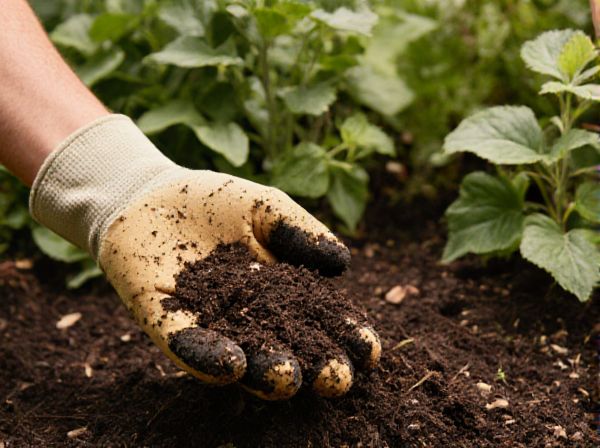
Mulching for weed suppression vs mulching for moisture retention Illustration
Mulching for weed suppression involves applying a thick layer of organic or inorganic material to block sunlight, preventing weed seeds from germinating and reducing the need for chemical herbicides. In contrast, mulching for moisture retention focuses on conserving soil moisture by minimizing evaporation and maintaining consistent soil temperature, which promotes healthier plant growth during dry periods. Choosing the right mulch type and thickness is essential to balance weed control and water conservation effectively.
Table of Comparison
| Aspect | Mulching for Weed Suppression | Mulching for Moisture Retention |
|---|---|---|
| Purpose | Blocks weed growth by limiting sunlight | Reduces soil evaporation, conserving water |
| Material Thickness | 3-4 inches of dense organic or synthetic mulch | 2-3 inches of loose organic mulch |
| Material Type | Dark-colored mulch, landscape fabric, or plastic sheeting | Straw, wood chips, bark, compost |
| Application Frequency | Reapply annually or when mulch degrades | Replenish regularly to maintain moisture barrier |
| Benefits | Significantly reduces weed growth and competition | Keeps soil moist, improves plant water uptake |
| Additional Effects | May inhibit beneficial plant seedlings if too thick | Enhances soil microbial activity and soil temperature regulation |
Understanding Mulch: Dual Benefits in the Garden
Mulching effectively suppresses weed growth by blocking sunlight, reducing the chance of weed seed germination and minimizing competition for nutrients in the garden soil. Simultaneously, mulch acts as a moisture retention barrier, reducing evaporation rates and maintaining consistent soil hydration essential for plant health. Selecting organic mulches like wood chips and straw enhances soil structure and microbial activity, amplifying these dual benefits for robust garden ecosystems.
Key Differences: Weed Suppression vs Moisture Retention
Mulching for weed suppression primarily involves using materials like bark chips or landscape fabric that block sunlight, preventing weed seed germination and growth. In contrast, mulching for moisture retention focuses on breathable organic materials such as straw or compost, which help retain soil moisture by reducing evaporation while allowing water infiltration. The key difference lies in the mulch composition and placement strategy to either inhibit weed development or conserve soil moisture effectively.
Types of Mulch: Which Works Best for Weeds or Water?
Organic mulches like shredded bark, compost, and straw excel at weed suppression by blocking sunlight and preventing seed germination. Inorganic mulches such as landscape fabric and black plastic are highly effective for moisture retention, reducing evaporation and maintaining consistent soil hydration. Combining organic mulch over landscape fabric can optimize both weed control and moisture retention in garden beds.
Organic vs Inorganic Mulch: Performance Comparison
Organic mulch, such as wood chips or straw, excels in weed suppression by creating a thick barrier that blocks sunlight and decomposes to improve soil health and moisture retention. Inorganic mulch, like landscape fabric or rubber mulch, provides superior long-term weed control by forming a durable, impervious layer but may not enhance soil moisture retention or nutrient content. Choosing between organic and inorganic mulches depends on prioritizing either soil enrichment and moderate moisture retention or robust, low-maintenance weed suppression.
How Mulch Prevents Weed Growth
Mulch prevents weed growth by blocking sunlight, which inhibits the germination and growth of weed seeds. Organic mulches like wood chips, straw, and bark create a dense barrier that suppresses weed emergence while also enriching the soil as they decompose. Inorganic mulches, such as landscape fabric and plastic sheeting, provide a physical shield that prevents weeds from penetrating the surface, effectively reducing competition for water and nutrients.
The Role of Mulch in Conserving Soil Moisture
Mulch plays a critical role in conserving soil moisture by creating a protective barrier that reduces evaporation and maintains consistent soil temperature. Organic mulch like wood chips or straw enhances moisture retention by improving soil structure and promoting microbial activity, which increases water absorption. This moisture conservation supports healthier plant growth and reduces the frequency of irrigation.
Application Techniques for Maximum Weed Control
Applying mulch with a thickness of 3 to 4 inches effectively suppresses weed growth by blocking sunlight and preventing seed germination. Using organic mulch such as bark or straw, combined with a pre-emergent herbicide, enhances weed control by creating a physical and chemical barrier. Properly layering mulch around plants while avoiding direct contact with stems minimizes moisture loss and protects root systems, optimizing both weed suppression and moisture retention.
Strategies for Mulching to Retain Soil Moisture
Mulching for moisture retention involves applying a thick, uniform layer of organic mulch, such as straw, shredded bark, or compost, to minimize soil evaporation and maintain consistent soil temperature. Selecting mulch materials with high water-holding capacity enhances soil moisture levels, encouraging healthy root development and reducing irrigation frequency. Proper mulching thickness, typically 2 to 4 inches, avoids water runoff while still allowing air permeability, optimizing soil hydration and promoting plant growth.
Balancing Weed Suppression and Moisture Retention Goals
Mulching effectively suppresses weed growth by blocking sunlight and creating a physical barrier, while also conserving soil moisture through evaporation reduction. To balance these goals, selecting mulch materials such as wood chips or straw that provide dense coverage yet allow water infiltration is essential. Proper mulch depth, typically 2-4 inches, ensures optimal weed suppression without impeding water absorption or soil aeration.
Common Mulching Mistakes and How to Avoid Them
Common mulching mistakes include applying mulch too thickly, which can suffocate plants and encourage mold growth, or using the wrong materials that fail to suppress weeds effectively. Mulching for weed suppression requires a dense, weed-resistant layer, such as bark chips or straw, while mulching for moisture retention benefits from organic materials like shredded leaves that improve soil hydration. To avoid these errors, maintain a mulch depth of 2-4 inches, keep mulch away from plant stems, and select mulch types tailored to your specific garden needs.
Mulching for weed suppression vs mulching for moisture retention Infographic

 gardendif.com
gardendif.com